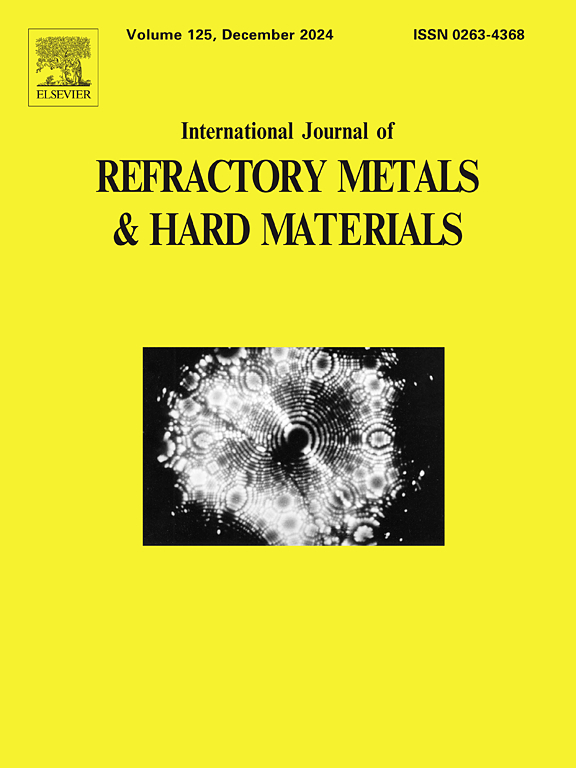L-PBF C103的超高温测试及性能研究
IF 4.2
2区 材料科学
Q2 MATERIALS SCIENCE, MULTIDISCIPLINARY
International Journal of Refractory Metals & Hard Materials
Pub Date : 2025-05-14
DOI:10.1016/j.ijrmhm.2025.107227
引用次数: 0
摘要
耐火合金的增材制造(AM)作为极端温度环境下部件的材料加工路线越来越受到关注。由于耐火合金的抗氧化性较低,必须开发新的方法来评估其高温性能。在这项工作中,对Gleeble®3800热机械负载架进行了改进,以评估激光粉末床熔合(L-PBF)固结铌合金C103在室温(RT)至1400℃范围内的力学性能。夹具和样品几何形状的设计,以适应焦耳加热和防止损坏测试室。通过在1E-5 Torr的真空水平下进行测试,将样品的氧化降到最低。极限抗拉强度(UTS),屈服强度(YS),伸长率和应变硬化行为被确定为温度的函数。L-PBF C103在室温下的平均拉伸强度为~ 650 MPa,伸长率超过25%。在室温以上,拉伸强度和拉伸强度在500℃至1000℃之间趋于平稳,范围为~ 400 MPa至~ 460 MPa,这与这类合金中观察到的动态应变时效一致。强度在1200℃后迅速下降到1400℃时的150mpa。断口形貌表明,C103在所有测试温度下都具有韧性断裂,电子背散射衍射(EBSD)分析显示,在1400℃测试时,样品的颈部区域存在织化组织和动态再结晶。本文章由计算机程序翻译,如有差异,请以英文原文为准。
Ultra-high temperature testing and performance of L-PBF C103
Additive Manufacturing (AM) of refractory alloys is gaining traction as a materials processing route for components subject to extreme temperature environments. Due to the low oxidation resistance of refractory alloys, novel methods for evaluating their elevated temperature performance must be developed. In this work, a Gleeble® 3800 thermomechanical load frame was modified to evaluate the mechanical properties of laser powder bed fusion (L-PBF) consolidated niobium alloy C103 ranging from room temperature (RT) to 1400 °C. The fixturing and sample geometry were designed to accommodate Joule heating and prevent damage to the test chamber. Oxidation of the samples was minimized via testing in vacuum level of 1E-5 Torr. Ultimate tensile strength (UTS), yield strength (YS), elongation, and strain-hardening behavior were determined as a function of temperature. L-PBF C103 presented an average UTS of ∼650 MPa and over 25 % elongation at RT. Above RT, the UTS and YS dropped then leveled off from 500 °C to 1000 °C with values ranging from ∼400 MPa to ∼460 MPa, which is consistent with dynamic strain aging observed in this class of alloys. The strength rapidly declined after 1200 °C to ∼150 MPa at 1400 °C. Fractography indicated ductile fractures for the C103 at all test temperatures, and Electron Backscatter Diffraction (EBSD) analysis revealed a textured microstructure and the presence of dynamic recrystallization within the necked region of the sample tested at 1400 °C.
求助全文
通过发布文献求助,成功后即可免费获取论文全文。
去求助
来源期刊
CiteScore
7.00
自引率
13.90%
发文量
236
审稿时长
35 days
期刊介绍:
The International Journal of Refractory Metals and Hard Materials (IJRMHM) publishes original research articles concerned with all aspects of refractory metals and hard materials. Refractory metals are defined as metals with melting points higher than 1800 °C. These are tungsten, molybdenum, chromium, tantalum, niobium, hafnium, and rhenium, as well as many compounds and alloys based thereupon. Hard materials that are included in the scope of this journal are defined as materials with hardness values higher than 1000 kg/mm2, primarily intended for applications as manufacturing tools or wear resistant components in mechanical systems. Thus they encompass carbides, nitrides and borides of metals, and related compounds. A special focus of this journal is put on the family of hardmetals, which is also known as cemented tungsten carbide, and cermets which are based on titanium carbide and carbonitrides with or without a metal binder. Ceramics and superhard materials including diamond and cubic boron nitride may also be accepted provided the subject material is presented as hard materials as defined above.

 求助内容:
求助内容: 应助结果提醒方式:
应助结果提醒方式:


